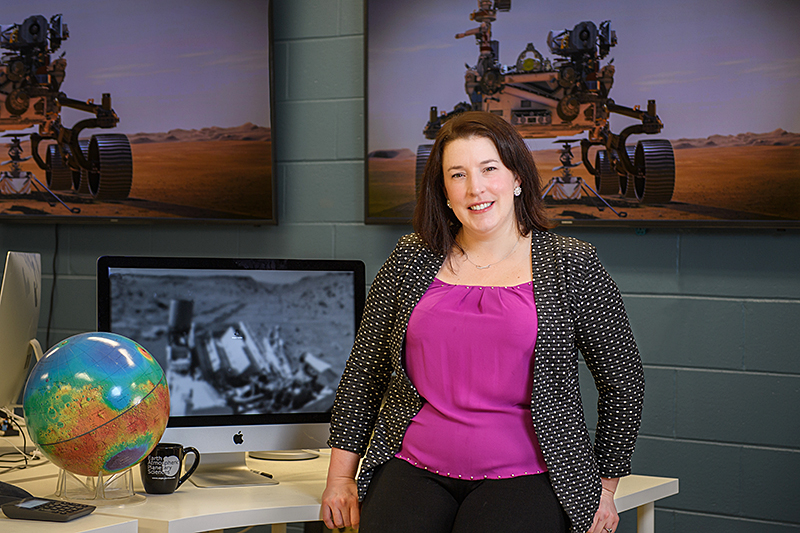February 9, 2021
Purdue scientist reflects on her passion for studying Mars’ geology, landscape
NASA rover has less than two weeks until reaching the red planet
WEST LAFAYETTE, Ind. — Briony Horgan grew up in Portland, Oregon, where, enjoying the mountains and volcanoes that surrounded the region, she developed a love of geology. A long-standing interest in space made Horgan realize she wasn’t confined to study rocks simply on Earth.
Horgan, now an associate professor of planetary science at Purdue, soon will have an opportunity to let her imagination dive into the geology of Mars as part of the NASA Mars rover Perseverance mission, which recently is more than halfway to Mars and has less than two weeks to landing on Feb. 18.
The rover will land in Jezero Crater, just north of the planet’s equator. The site used to be a lake and large river delta on the planet. She has played a key role in the mission, including leading mineralogy research. Her team came up with an important finding on the location that contributed to Jezero Crater’s selection, and she helped design the camera that will be the scientific eyes for Perseverance.
Horgan’s research and a presentation led NASA to select the rover landing site. (Horgan talks about her interest in the rover mission in this video)
“Geology was something I absolutely loved because it explains how the world around us came to be over millions and billions of years,” Horgan said. “Doing that in space is even more interesting because the time scales are even more crazy. On Mars, we’re talking about 4 billion years of evolution that produced the rocks we see.”
It was the 2003 landing of the Mars rover Spirit that has driven Horgan’s imagination and her career for the last 17 years.
“Seeing those images come back from the surface was absolutely incredible, and that’s what inspired me to pursue planetary science,” she said.
The NASA rover Perseverance launched on July 30 from Florida’s Cape Canaveral Air Force Station.
 Briony Horgan, associate professor of planetary science, stands in front of the VOSS Model on Purdue’s campus. A childhood interest in space and the mountains near her home has led to her work on the latest NASA rover mission to study Mars. (Purdue University photo/John Underwood)
Briony Horgan, associate professor of planetary science, stands in front of the VOSS Model on Purdue’s campus. A childhood interest in space and the mountains near her home has led to her work on the latest NASA rover mission to study Mars. (Purdue University photo/John Underwood)
Horgan said she loves being able to get into a plane and look down at the Earth and know how a mountain range formed over millions of years, given her studies in geology. But she admits February’s landing of the latest Mars rover will take her imagination to new heights.
“The place we’re going on Mars, no human eyes have ever seen before,” she said. “I can’t wait to get onto the surface of the planet and see a new place for the first time through the eyes of the rover.
“It is going to be absolutely inspiring,” Horgan said. “We’ll be the first humans to see this place on Mars, the first to try to understand what is it telling us about Mars.”
About Purdue University
Purdue University is a top public research institution developing practical solutions to today’s toughest challenges. Ranked the No. 5 Most Innovative University in the United States by U.S. News & World Report, Purdue delivers world-changing research and out-of-this-world discovery. Committed to hands-on and online, real-world learning, Purdue offers a transformative education to all. Committed to affordability and accessibility, Purdue has frozen tuition and most fees at 2012-13 levels, enabling more students than ever to graduate debt-free. See how Purdue never stops in the persistent pursuit of the next giant leap at https://purdue.edu/.
Writer, Media contact: Brian Huchel, 765-494-2084, bhuchel@purdue.edu
Source: Briony Horgan, briony@purdue.edu, @ironywithab
Journalists visiting campus: Journalists should follow Protect Purdue protocols and the following guidelines:
- Campus is open, but the number of people in spaces may be limited. We will be as accommodating as possible, but you may be asked to step out or report from another location.
- To enable access, particularly to campus buildings, we recommend you contact the Purdue News Service media contact listed on the release to let them know the nature of the visit and where you will be visiting. A News Service representative can facilitate safe access and may escort you on campus.
- Correctly wear face masks inside any campus building, and correctly wear face masks outdoors when social distancing of at least six feet is not possible.
Note to journalists: Various photos, video and interview clips of Briony Horgan as well as NASA images related to the Mars rover mission, are available via this Google Drive folder.

